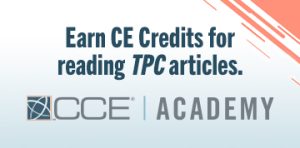Sep 17, 2013 | Book Reviews
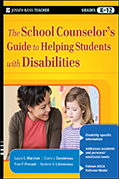 The insight, information and strategies provided in the book, The School Counselor’s Guide to Helping Students with Disabilities, are valuable resources for practicing school counselors and counselor educators. The book offers strategies for meeting the needs of students with disabilities more effectively.
The insight, information and strategies provided in the book, The School Counselor’s Guide to Helping Students with Disabilities, are valuable resources for practicing school counselors and counselor educators. The book offers strategies for meeting the needs of students with disabilities more effectively.
The School Counselor’s Guide to Helping Students with Disabilities is divided into three parts. Part 1 provides foundational knowledge for school counselors and helps readers integrate information about disabilities into their counseling programs. Chapter 1 highlights school counselors’ roles regarding students with disabilities and explains the specialized developmental needs of such students as compared to their peers. Chapter 2 discusses common assumptions about students with disabilities and provides tools to help counselors interact with the students’ families more effectively. Chapter 3 explains how to transform a traditional school counseling program into one that facilitates competency development for students with disabilities. This chapter also provides information on including students with disabilities in school counseling programs and offers leadership and advocacy guidelines for school counselors. Chapter 4 explains the school counselor’s role in the individualized education program (IEP), Section 504, Plans and Transition Plans. Chapter 5 provides ways for school counselors to form effective partnerships with parents and highlights frequent experiences, feelings and realities of parents of children with disabilities, based on the authors’ experiences and knowledge.
Part 2 of the book focuses on the academic, personal/social and career domains from the American School Counselor Association (ASCA). Chapter 6 discusses ways in which school counselors play a crucial role in addressing the academic needs of students with disabilities, and it includes methods that help teachers create positive learning environments for students. Chapters 7 and 8 examine students’ social and personal needs, focusing on the effects of peer relationships. These chapters also include strategies for school counselors that promote social integration within schools. While describing the central needs and challenges of children with disabilities, Chapter 9 concentrates on the importance of career education and development. It also gives guidelines on preparing students for the transition from school to work, training or higher education.
Part 3 delivers practical information about disabilities, as detailed within each category of the Individuals with Disabilities Education Act (IDEA). For each disability, the authors provide general information; what students and parents with the disability wish teachers and school counselors knew; practical applications in each of the ASCA domains; and resources containing more information about the specific disability.
The collective knowledge and experience of the authors, who are expert school counselors, make this book rich in valuable content. As a future school counselor, I find that this book provides fundamental resources for assisting students with disabilities. The information in this book soundly represents the ASCA domains for future school counselors. Reading this book would benefit educators, parents and anyone interested in working alongside students with disabilities.
Marshak, L. E., Dandeneau, C. J., Prezant, F. P., & L’Amoreaux, N. A. (2010). The School Counselor’s Guide to Helping Students with Disabilities. New York, NY: Springer Publishing Company.
Reviewed by: Estefanía Riveros, Miami, Florida.
The Professional Counselor Journal
HOME PAGE
May 30, 2013 | Article
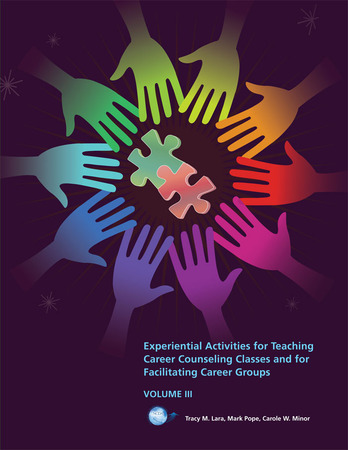 The experiential activities in Experiential Activities for Teaching Career Counseling Classes and for Facilitating Career Groups are an invaluable tool in the counseling field. It is a comprehensive and didactic approach to career counseling for the counselor educator.
The experiential activities in Experiential Activities for Teaching Career Counseling Classes and for Facilitating Career Groups are an invaluable tool in the counseling field. It is a comprehensive and didactic approach to career counseling for the counselor educator.
Each chapter is well organized in clearly stating purpose, learning objectives, application of theory, target population, setting, materials needed and instructions. The content identifies key areas in career counseling consisting of theoretical orientations in counselor education development, assessment tools, pragmatic exercises and technological resources. The self-knowledge exercises help the counselor educator in resolving one’s ambivalence in making sound career choices.
Lara, Pope and Minor incorporate practical lessons that make learning interesting and educational. Important aspects of counselor education have been covered in the book through group activities that enhance self-awareness, knowledge and broaden one’s worldview. The ‘Order in Chaos’ exercise allows an opportunity for counselor educators to perceive the complexities and patterns in career development. The assessments help identify values that counselor educators could incorporate into their training. The importance of networking is highlighted to help future employees in their job search. The exercises focus on preparing future employees in obtaining gainful employment and a successful career path. The book lists various technologies available to counselors to provide vital information and update their knowledge of current research trends in the field of career counseling.
This pragmatic guide for counselor educators reaches out to a diverse population. With an emphasis on career development, the book plays a significant role in helping future counselors with job readiness, which is very vital in today’s fast paced world. Gaining knowledge from the book, counselors can become self-confident and motivated in performing effectively in their profession.
Throughout the book, the authors accentuate core competencies of counselor education. In the reflections and evaluations, the reader can discern several significant concepts in counselor education. Thought provoking objectives, case scenarios and discussion questions throughout the book give the reader a better understanding of each topic rather than learning the material by rote. With limited research available on group counseling, the book guides counselors from all related fields to help clients resolve their problems. The counselor-client relationship is fostered in mutual learning of acceptance, empathy and respect in their interaction. I think this well-written and easily comprehensible book will help educators utilize a hands-on approach in teaching without undermining the theoretical element in counseling. Using assessment tools and practical exercises help in determining the individual’s strength and interests.
Experiential Activities for Teaching Career Counseling and For Facilitating Career Groups is a must read book for every counselor educator. The book aims at teaching the material in an interesting manner, while educating counselors to be better clinicians and well-rounded individuals. It is designed in a universally structured educational framework with the objective of producing creative and ethical individuals that value integrity in a progressive world.
Lara, T., Pope, M., & Minor, C. (2011). Experiential Activities for Teaching Career Counseling Classes and for Facilitating Career Groups: Volume 3. Broken Arrow, OK: National Career Development Association.
Reviewed by: Shanti Nair, doctoral counseling student, Barry University, Miami Shores, Florida.
The Professional Counselor Journal
HTTP://tpcwordpress.azurewebsites.net
May 20, 2013 | Book Reviews
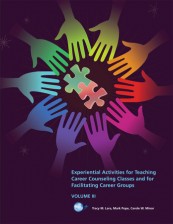 The experiential activities in Experiential Activities for Teaching Career Counseling Classes and for Facilitating Career Groups are an invaluable tool in the counseling field. It is a comprehensive and didactic approach to career counseling for the counselor educator.
The experiential activities in Experiential Activities for Teaching Career Counseling Classes and for Facilitating Career Groups are an invaluable tool in the counseling field. It is a comprehensive and didactic approach to career counseling for the counselor educator.
Each chapter is well organized in clearly stating purpose, learning objectives, application of theory, target population, setting, materials needed and instructions. The content identifies key areas in career counseling consisting of theoretical orientations in counselor education development, assessment tools, pragmatic exercises and technological resources. The self-knowledge exercises help the counselor educator in resolving one’s ambivalence in making sound career choices.
Lara, Pope and Minor incorporate practical lessons that make learning interesting and educational. Important aspects of counselor education have been covered in the book through group activities that enhance self-awareness, knowledge and broaden one’s worldview. The ‘Order in Chaos’ exercise allows an opportunity for counselor educators to perceive the complexities and patterns in career development. The assessments help identify values that counselor educators could incorporate into their training. The importance of networking is highlighted to help future employees in their job search. The exercises focus on preparing future employees in obtaining gainful employment and a successful career path. The book lists various technologies available to counselors to provide vital information and update their knowledge of current research trends in the field of career counseling.
This pragmatic guide for counselor educators reaches out to a diverse population. With an emphasis on career development, the book plays a significant role in helping future counselors with job readiness, which is very vital in today’s fast paced world. Gaining knowledge from the book, counselors can become self-confident and motivated in performing effectively in their profession.
Throughout the book, the authors accentuate core competencies of counselor education. In the reflections and evaluations, the reader can discern several significant concepts in counselor education. Thought provoking objectives, case scenarios and discussion questions throughout the book give the reader a better understanding of each topic rather than learning the material by rote. With limited research available on group counseling, the book guides counselors from all related fields to help clients resolve their problems. The counselor-client relationship is fostered in mutual learning of acceptance, empathy and respect in their interaction. I think this well-written and easily comprehensible book will help educators utilize a hands-on approach in teaching without undermining the theoretical element in counseling. Using assessment tools and practical exercises help in determining the individual’s strength and interests.
Experiential Activities for Teaching Career Counseling and For Facilitating Career Groups is a must read book for every counselor educator. The book aims at teaching the material in an interesting manner, while educating counselors to be better clinicians and well-rounded individuals. It is designed in a universally structured educational framework with the objective of producing creative and ethical individuals that value integrity in a progressive world.
Lara, T., Pope, M., & Minor, C. (2011). Title . Broken Arrow, OK: National Career Development Association.
Reviewed by: Shanti Nair, doctoral counseling student, Barry University, Miami Shores, Florida.
The Professional Counselor Journal
https://tpcwordpress.azurewebsites.net
Apr 19, 2013 | Book Reviews
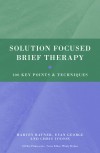 Ratner, George, and Iveson’s Solution Focused Brief Therapy: 100 Key Points Techniques, direct BRIEF, a coaching, therapy, training, and consulting center in London which currently happens to be the largest brief therapy training center in the world. The authors’ vast Solution Focused Brief Therapy (SFBT) experience is highlighted throughout the text.
Ratner, George, and Iveson’s Solution Focused Brief Therapy: 100 Key Points Techniques, direct BRIEF, a coaching, therapy, training, and consulting center in London which currently happens to be the largest brief therapy training center in the world. The authors’ vast Solution Focused Brief Therapy (SFBT) experience is highlighted throughout the text.
Supplied in an easy to read format, Solution Focused Brief Therapy: 100 Key Points & Techniques offers multiple relevant clinical case vignettes to guide the reader through the 100 points and techniques. The case examples are highly nuanced, further demonstrating the authors’ mastering of solution focused brief therapy and increasing the value and utility of the book. Solution focused practitioners search for instances of success in client’s lives, whereby creating new dialog outside of problem focused talk. In solution focused practice, common questions are those of difference: ‘What has worked in the past?’, ‘What difference are you hoping that will make?’, and ‘Who else would notice that coming here has been useful for you?’. Point 66 of 100 is a direct example; under the part on conducting follow-up sessions, subtitled, When the client says things are worse , the authors write: “There will be a time when every solution focused brief therapist asks [the client(s)], ‘so what has been better’ and the client will answer ‘you’re joking surely, it’s been worse, ten times worse. This week has been the worst week of my life’. While it can be tempting for the panicky counselor to try to trick the client out of his position [by responding] ‘but you got yourself here – how did you manage that?’. This statement from the practitioner contains the underlying logic of ‘if things were really so bad you wouldn’t be here, but you are here so it cannot be that bad’. The authors suggest this approach is always worth avoiding, because it does not validate the client’s difficulty before redirecting the conversation. This short clinical example is one of many housed within the 100 points in this text.
Solution Focused Brief Therapy: 100 Key Points & Techniques contains 16 parts which are further subdivided by the 100 key points and techniques. The authors begin Part I with the background of SFBT by discussing the Mental Research Institute in Milwaukee, social construction by Ken Gergen, Wittgenstein and his famous language games, and collaborative approaches to counseling. Part I ends with the assumptions of the client-counselor relationship, change processes, key assumptions, and an outline of first session goals. Part II describes compliments, taking turns in speech and acknowledging possibility. Part III, subtitled ‘Getting Started’ describes the beginning of therapy, techniques, and vital information to begin SFBT including a ‘resource audit.’
Part IV focuses on establishing a contract, or the joint project. The joint project function is finding the client’s best hopes from counseling, with guidelines for establishing a contract with involuntary clients and young clients. The authors describe the difference between outcome and process wherein the contract must contain a true ‘in-life’ difference versus working with a goal of ‘I just want to get things off my chest’. Part V describes broadening and detailing the client’s preferred future by the tomorrow question a derivative of the miracle question, and five key points to help the practitioner in defining and detailing preferred futures. Part VI describes exceptions, no exceptions and creating resource lists.
Part VII details the scaling techniques to measure progress, and practitioners helping clients to move up the scale. Part VIII outlines coping questions during difficult client stories and what to do during difficult sessions with issues such as bereavement. Part IX describes the role of the SFBT therapist during the termination process with Part X examining the follow-up sessions. Part XI is tailored to ending the work with clients, while XII is dedicated to assessment within SFBT. The next two sections are handling specific populations such as children, families, group work and adults. Part XV is dedicated to supervision, coaching, and organizational uses, with the last subtitle Part XVI answering frequently asked questions. This book is a worthy addition to any counselor’s bookshelf.
Ratner, H., George, E., & Iveson, C. (2012) . Solution focused brief therapy: 100 key points and techniques. New York, NY: Routledge.
Reviewed by: George E. Harrington III, doctoral counseling student, Barry University, Miami Shores, Florida.
The Professional Counselor Journal
HOME PAGE
Mar 27, 2013 | Video Reviews
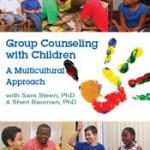 In these videos, Sam Steen, Ph.D., and Sheri Bauman, Ph.D., utilizes therapeutic interventions in their group counseling collaboration to create effective ways of educating children about diversity. Steen and Bauman introduce the video by sharing the necessary steps in group formulation and preparation: planning, screening, modeling, self-disclosure (not too personal), processing (reflect, think and ponder) and evaluating (age appropriate and specific to the group). Throughout these videos, counselors are instructed in how to replicate groups.
In these videos, Sam Steen, Ph.D., and Sheri Bauman, Ph.D., utilizes therapeutic interventions in their group counseling collaboration to create effective ways of educating children about diversity. Steen and Bauman introduce the video by sharing the necessary steps in group formulation and preparation: planning, screening, modeling, self-disclosure (not too personal), processing (reflect, think and ponder) and evaluating (age appropriate and specific to the group). Throughout these videos, counselors are instructed in how to replicate groups.
Steen and Bauman co-facilitate this group to help these children understand cultural diversity, or multiculturalism. They create a safe environment in which children can interact, and they teach diversity using fun educational tools such as ice cream and songs. Therefore, demonstrating diversity is constantly prevalent in our surroundings.
A unique perspective on the demonstration of activities is displayed in this video, which also illustrates how a therapeutic bond is formed. This positive bond between youth and counselor can be based on relational features, such as the degree to which the therapist is being stimulating, humorous or rewarding, especially with young children. The video is exceptional in how the children are addressed and encouraged to engage.
The lack of cognitive development can limit a younger client’s ability to evaluate connections between therapy tasks and goals, and the involvement of parents and other caregivers in youth therapy can complicate the issue of goal consensus. Steen and Bauman effectively illustrate how to go beyond such roadblocks to create a therapeutic alliance and establish treatment outcomes for these multicultural issues.
Throughout the video, Steen and Bauman illustrate both humorous and serious themes that can be addressed in diversity. There are a total of six (6) sessions, all of which contain information that a therapist can take away and utilize when leading groups, or even with younger individual clients. Different activities are carried out throughout the sessions, such as “diversity beans,” “name color,” “comfort zones,” and “about your culture,” to name a few. Some of these can be used in the classroom to make children more aware of diversity, whether it will be processed further than the surface level observations or not. Although every activity has an element of fun, each activity is effective and always follows through with purpose and reflections. Despite the fact that counselors and clients were videotaped, they were able to give an accurate depiction of group dynamics and cohesion, as well as therapeutic practices and outcomes.
While therapeutic styles are personal and are as important as techniques and theories, counselors can utilize these techniques to blend with their own styles and the needs of their clients to produce valuable outcomes. This video shows that Steen and Bauman are successful in demonstrating a practical and technical approach using innovative techniques and activities.
I would highly recommend this video to anyone who works with younger clients even if it is only to add techniques to your battery of information to help these young people view the world in a new way by appreciating differences.
Psychotherapy.net (Producer), & Gallego, T. (Director). (2011). Group counseling with children: A multicultural approach [DVD]. Available in DVD and video streaming from http://www.psychotherapy.net/video/diversity-group-children
Reviewed by: Josephine L. Rodriguez, NCC, doctoral counseling student, Barry University, Miami Shores, Florida.
The Professional Counselor Journal
HOME PAGE
Mar 21, 2013 | Video Reviews
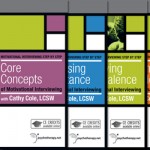 Psychotherapy.net and Cathy Cole have developed an impactful DVD series on Motivational Interviewing (MI). This 2012 series illustrates how motivational interviewing is a counseling approach to improve how counselors and clients have conversations. These DVDs are up-to-date and current with a natural flow to the interview conversations. The DVDs serve as a resource to introduce counselors-in-training to MI. Furthermore, the series is a refresher for counselors who have been trained in the past and need a thought- provoking experience to reaffirm the positive impact that this Rogerian-focused technique can provide. The process reinforces client autonomy as the counselor and client join together to create a matrix for change. Rather than the counselor being an ‘expert,’ Cole states that it is important to ask permission of the client to share information. The four part series covers the core principles of increasing importance, building confidence, and resolving ambivalence.
Psychotherapy.net and Cathy Cole have developed an impactful DVD series on Motivational Interviewing (MI). This 2012 series illustrates how motivational interviewing is a counseling approach to improve how counselors and clients have conversations. These DVDs are up-to-date and current with a natural flow to the interview conversations. The DVDs serve as a resource to introduce counselors-in-training to MI. Furthermore, the series is a refresher for counselors who have been trained in the past and need a thought- provoking experience to reaffirm the positive impact that this Rogerian-focused technique can provide. The process reinforces client autonomy as the counselor and client join together to create a matrix for change. Rather than the counselor being an ‘expert,’ Cole states that it is important to ask permission of the client to share information. The four part series covers the core principles of increasing importance, building confidence, and resolving ambivalence.
The first DVD, Motivational Interviewing Step by Step: Core Concepts, provides the viewer with the building blocks for conducting a MI along with the rational for each step. Victor Yalom and Cathy Cole have a smooth style of walking the viewer through the process and their conversations are highlighted by simple graphics to reinforce the basic points. The DVDs also are good to just listen to on a long drive to enhance the learning experience. For example, Cole talks about the mnemonic of those “DARN CATS” and how following these steps can result in a beneficial conversation.
Motivational Interviewing Step by Step: Building Confidence is the second DVD and helps to instill confidence in both the client and the counselor. The four principles of MI: (1) expressing empathy, (2) developing discrepancy, (3) rolling with resistance/reflecting discord, and (4) supporting self-efficacy are explained and illustrated throughout the series with clear and logical examples.
The third DVD is Motivational Interviewing Step by Step: Increasing Importance. The disc has three excellent counseling sessions by Cole who brings to life the importance of various points. For example, too often a counselor when confused about an issue will revert to asking question after question. Cole demonstrates that continued reflection is important so that the client does not feel ‘grilled.’
The fourth DVD, Motivational Interviewing Step by Step: Resolving Ambivalence, encourages the counselor to assist the client in using what is known by the client and then encouraging that more information be sought. MI helps the client explore ambivalence and look at different resources and information, which may help the client explore their thoughts. The series also is strong as it provides examples for various work environments for counselors such as EAP or agency. The clients are in various stages of counseling from initial intake to established clients so the viewers get a broad understanding of MI.
Overall, the series is well produced, informative and helps the viewer form a clear understanding of the motivational interviewing (MI) approach. Within the DVDs there are helpful meta-processing comments regarding the counseling sessions. The accompanying manuals also have wonderfully constructed discussion questions, informational summaries and transcripts of the sessions.
Motivational interviewing step by step (4 DVD series) [DVD]. Psychotherapy.net (Director) (2012). Available in DVD and Video Streaming at http://www.psychotherapy.net/MI
Reviewed by: Matthew Mims, NCC, University of Nebraska at Kearney, Kearney, Nebraska.
The Professional Counselor Journal
HOME PAGE
Mar 20, 2013 | Book Reviews, Non-English Texts
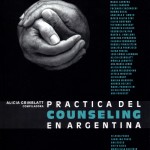 Alicia Grinblatt (2008) ha compilado las experiencias de 48 counselors Argentinos. Siendo ella misma una Counselor, ha logrado capturar el trabajo anónimo que los consejeros realizan día a día (p.11). El libro está dividido en 13 áreas incluyendo adicciones, sexualidad, supervisión, y counseling educacional, entre otros. Andrés Sánchez Bodas (p. 15) remarca que cada texto en el libro emerge de la práctica profesional. Cada capítulo provee la representación del estado del Counseling en el país acorde con las experiencias de su autor; su pasión por la profesión, y sus expectativas para el futuro.
Alicia Grinblatt (2008) ha compilado las experiencias de 48 counselors Argentinos. Siendo ella misma una Counselor, ha logrado capturar el trabajo anónimo que los consejeros realizan día a día (p.11). El libro está dividido en 13 áreas incluyendo adicciones, sexualidad, supervisión, y counseling educacional, entre otros. Andrés Sánchez Bodas (p. 15) remarca que cada texto en el libro emerge de la práctica profesional. Cada capítulo provee la representación del estado del Counseling en el país acorde con las experiencias de su autor; su pasión por la profesión, y sus expectativas para el futuro.
El libro cubre una variedad de áreas, poblaciones y escenarios. Todas las secciones incluyen discusiones sobre el tema, estrategias usadas para abordarlo, y las experiencias de los counselors en el campo. Algunos capítulos enfatizan la descripción de experiencias de campo; Claudia Fernández (p. 57) escribió acerca de los sentimientos y experiencias de personas con esclerosis múltiple; sus dificultades en la búsqueda de ayuda y su necesidad de sentirse apoyados. Fernández proyecta una vida de servicio y la inspiración por hacer la diferencia en la vida de otros. Silvia Perazzo (p. 100) también describe sus experiencia personales; expresa de manera genuina sus dudas, retos, y su recorrido profesional en el trabajo con niños. Su historia es un ejemplo de determinación y crecimiento personal; un camino de auto-descubrimiento profesional, una búsqueda continua de respuestas y recursos, y una vida construyendo relaciones de apoyo. Otros autores comparten estrategias específicas que están siendo usadas en Argentina. María Felisa Díaz (p. 31) describe un proyecto de inclusión social para adolescentes; Mabel Carrera, Rosel Carrere y Federico Elizalde (p. 23) describen un proceso de consejería de grupo ofrecida a personas que han sido liberadas de prisión; Silvia Mount (p.71) presenta una propuesta educativa usada en una institución de educación pre-escolar; y Verónica Peluffo de Apellaniz (p. 122) explica su trabajo con talleres de prevención de adicciones basados en niveles de comunicación y grupos de apoyo. Estos y muchos otros capítulos del libro constituyen un buen recordatorio de la relevancia del Counseling, la necesidad de la profesión y su impacto en la vida de las personas.
Algunos capítulos se refieren a temas más específicos. María Teresa Toscano (p. 112) explica el significado del término familias ensambladas; familias que han surgido de segundos matrimonios o uniones, donde todos los miembros de la familia tienen que conocerse unos a otros y construir un futuro juntos. Graciela B. Francisco (p. 134) discute el tema de adicciones en adolescentes y las necesidades de sus padres; la importancia de la dinámica familiar y estrategias para consejeros que trabajan con esas familias. Raquel Finkelstain (p. 163) introduce el tema de negocios familiares desde una perspectiva del counseling organizacional, y las dificultades que surgen de la dinámica entre las relaciones personales y los roles profesionales establecidos. Todos temas pertine
El libro Practica del Counseling en Argentina incluye una variedad tan amplia de tópicos que se hace imposible incluirlos todos en esta breve revisión. Sin embrago, se espera que los fragmentos seleccionados sirvan como una guía de temas a explorar; como reflexión acerca de los posibles usos del libro; y como un motivador para considerar este recurso bibliográfico. Es además importante mencionar que a pesar de que el libro ha sido escrito con base en el enfoque Centrado en la Persona, incluye además una sección completa que explora otros enfoques tales como Gestalt y Psicodrama; además de un numero de estrategias creativas que incluyen el trabajo con sonidos, expresiones orales, y conciencia corporal entre otros. ntes e innovadores en el campo del Counseling.
El libro Practica del Counseling en Argentina es una inspiración para todo counselor. Profesionales novatos pueden informarse acerca de los sentimientos, expectativas, y retos que todo Counselor tiene al inicio de su carrera profesional; Mientras que Counselors con más experiencia en el campo pueden utilizar este libro como una herramienta para relacionarse con otros e informarse acerca de las nuevas tendencias del Counseling en Argentina. Por otra parte, counselors expertos también pueden hacer uso de esta compilación de conocimientos y experiencias profesionales en el campo, para futuros proyectos de investigación y práctica. La esencia de este trabajo es capturada por Silvia Munt (p.70) con su frase: “Hay tanto por hacer… y yo solo tengo dos manos… que se pueden entrelazar con otras y otras y así formar redes que contengan…”
Grinblatt, A. (Ed.). (2008). Práctica del counseling en Argentina. Buenos Aires, Argentina: Georges Zanun Editores.
Revisado por:, Consejera Certificada en los Estados Unidos (NCC), estudiante de doctorado, Universidad Estatal de Carolina del Norte, Raleigh, Carolina del Norte.
The Professional Counselor
https://tpcwordpress.azurewebsites.net
Feb 25, 2013 | Book Reviews
 The first section of the book, Understanding and Promoting Healthy Development, focuses on the developmental issues affecting males from birth to adulthood. Although the authors briefly mention females in the section, males and their distinctiveness are further explored and explained. Males tend to benefit from therapeutic modalities catered towards action and activity. Furthermore, creating a supportive therapeutic milieu and avoiding interventions detrimental to the client’s progress, is integral. As part of the focus on developmental issues, the book discusses the intellectual range within the male population, from the gifted to persons with learning disabilities. Indubitably, understanding the nuances of the male species provides a greater opportunity to encourage boys and young men towards therapeutic goals.
The first section of the book, Understanding and Promoting Healthy Development, focuses on the developmental issues affecting males from birth to adulthood. Although the authors briefly mention females in the section, males and their distinctiveness are further explored and explained. Males tend to benefit from therapeutic modalities catered towards action and activity. Furthermore, creating a supportive therapeutic milieu and avoiding interventions detrimental to the client’s progress, is integral. As part of the focus on developmental issues, the book discusses the intellectual range within the male population, from the gifted to persons with learning disabilities. Indubitably, understanding the nuances of the male species provides a greater opportunity to encourage boys and young men towards therapeutic goals.
Seemingly, dyadic relationships are significant in the development of young men. Relationship Development and Relationship Concerns, the second section of the book, examines the complexities of young males’ interpersonal relationships. Family dynamics, romantic involvement, and sexual identity are the topics discussed in the aforementioned section. Accordingly, the authors elucidate the varying degrees of relationship issues and provide practical techniques for assisting males with these issues.
Emotional and Mental Health Concerns and Behavior Disorders and Concerns, the final sections of the text, outline the pervasiveness of mental health issues and the affects of conduct related behavioral disorders among young males. Presumably, young men tend to be commonly diagnosed with inattentive and conduct related disorders. Despite the apparent ubiquitous nature of specific disorders affecting young males, the authors assert specific treatment modalities may alleviate the therapeutic process. Moreover, environmental aspects of an individual’s life are certainly contributory factors to potential disorders. Thus, exploring ancillary aspects of young males’ lives is imperative in examining potential treatment avenues.
Counseling Boys and Young Men provides a plethora of information and counseling techniques essential to the continued development of young men. The counseling nomenclature is accurate and serves as a point of reference for novice and experienced counselors alike. The book offers a chapter on adolescent diversity; however, multicultural issues and the significance of distinctiveness could be further explored. The text serves as a noteworthy manual addressing the myriad of issues affecting young males in today’s society.
Degges-White, S., & Colon, B. (2012). Counseling Boys and Young Men. New York, NY: Springer Publishing Company.
Reviewed by: Jadarius Jackson, graduate student, North Carolina A&T State University, Greensboro, North Carolina.
The Professional Counselor Journal
HOME PAGE
Feb 10, 2013 | Video Reviews

The Leading Groups with Adolescents video presents a fishbowl view of an actual psychoeducational group. The presenters carefully outline each highly structured step in the process and then proceed to facilitate each step before the camera where viewers are vicariously drawn into the process. At times, due to the actual believability of the group experience, I forgot I was a passive observer and not a member.
The participants are not actors– probably second-semester sophomores, who were chosen for training as peer mediators. It is obvious the students are high achieving, articulate and poised teens. As the leaders move the group process forward, the students become more real, more genuine, and more able to present themselves, warts and all, with more comfort and depth. To DeLucia-Waack’s credit, she acknowledges that this group of teens is probably the ideal for a psychoeducational group. Before the actual group begins, midway through the eight-hour group, and at the end, the presenters meet with Dr. Arthur Horne. As the outside moderator, he sets the stage and processes the group encounter. The articulation of counseling foundations and explanations of the authors’ purposes that he provides is certainly a strong addition to skills training.
For learning teen group psychoeducational skills, this DVD may be as valuable, or more so than a college lecture class. It’s of the A+ variety. When promoting the value of groups in comparison to individual therapy for teens, the presenters stress that adolescent groups remove the adult-as-authority impediment. These teens clearly demonstrate honest engagement with one another, and the use of preferential learning modalities to become both students and peer-teachers. The focus on the cognitive behavioral feeling-thinking-acting ABC model is, in itself, praiseworthy. For skills training in leading teen groups, this segment alone provides a vignette gem of CBT in action. In addition, the demonstration of termination is worth the price of the video.
Although the production has top-notch training potential, more cultural diversity would have strengthened the overall believability of the messages. There are only two teen male group members. The presenters, the group members and the moderator are Caucasian. Having a male and a female leader, however, is a stellar plus for modeling in teen groups. DeLucia-Waack’s energized presentation style can be both engaging and somewhat bothersome. Segrist’s restrained, almost somnolent style both negatively magnifies and positively compliments Delucia-Waack’s force. Certainly his role of getting the group physically involved in the process speaks volumes for the need for pacing, body-mind learning and active engagement in working with teen groups. As a tool, Leading Groups with Adolescents, is a worthwhile training DVD. The accompanying handbook further enhances the viewer’s ability to successfully use material from the video and actualize effective teen group work. Even with the absence of some of my personal “wants and needs,” I wholeheartedly recommend Leading Groups with Adolescents. There is icing on the cake – CEU credits are available for this video.
DeLucia-Waack, J., & Segrist, A. (Director). (2011). Leading groups with adolescents [DVD] New York, NY: Springer. Available from https://www.psychotherapy.net/video/psychoeducational-group-adolescents.
Reviewed by: J. Dwaine Phifer, NCC, DonLin Counseling Services, Statesville, NC.
The Professional Counselor
HOME PAGE
Jan 29, 2013 | Book Reviews
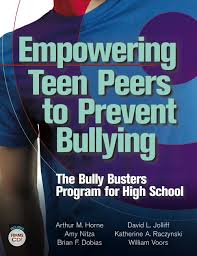 In this manual, the authors provide a research-based model for developing safer and more inviting schools. This well-written manual is logically ordered and based on expertise and experiential success. Teens teaching one another is the cornerstone of this empowerment program. Upperclassmen intensively train to become peer leaders for freshmen, conducting small group sessions during school hours. As the group matures, the leaders focus on building interpersonal and community connections. Teens begin talking about, and honestly listening to individual experiences with bullying, teasing and harassment at school. Trust building becomes the foundation for acceptance and personal growth. Through empathic understanding, students gain courage to confront bullying and avoid passive acceptance. The productive communication training material stresses that “talking at or about” is not communication, whereas listening is the key. Choice-making practice leads students to “stop, think and decide” before acting. Learning about locus of control aids the understanding of how “out there” influences “inside” in decision-making. Practice in conflict resolution helps students center on the STOPP model. Learning about healthy relationships ensures didactic understanding and steers behavioral change.
In this manual, the authors provide a research-based model for developing safer and more inviting schools. This well-written manual is logically ordered and based on expertise and experiential success. Teens teaching one another is the cornerstone of this empowerment program. Upperclassmen intensively train to become peer leaders for freshmen, conducting small group sessions during school hours. As the group matures, the leaders focus on building interpersonal and community connections. Teens begin talking about, and honestly listening to individual experiences with bullying, teasing and harassment at school. Trust building becomes the foundation for acceptance and personal growth. Through empathic understanding, students gain courage to confront bullying and avoid passive acceptance. The productive communication training material stresses that “talking at or about” is not communication, whereas listening is the key. Choice-making practice leads students to “stop, think and decide” before acting. Learning about locus of control aids the understanding of how “out there” influences “inside” in decision-making. Practice in conflict resolution helps students center on the STOPP model. Learning about healthy relationships ensures didactic understanding and steers behavioral change.
Developmentally, the last half of the manual infuses power into the groups’ experiential process. The last two chapters lead students into actualization of their new skills through closure and implementation. This text and its accompanying peer leader guide offer schools a potent and effective way to reduce the venomous, terrifying effects of bullying. Whereas bullying is sometimes written off as “kids being kids,” or “a rite of passage,” adults must accept that bullying is a pernicious malevolence that destroys. With archetypal teen sturm and drang and a brain that can no longer think like a child’s and is incapable yet of full rational adult cognition, even a typical “good” adolescent can fall into the trap of bullying. Bullying may be due to peer pressure, an instinct for social survival, a passive “don’t see–don’t tell” approach, or a combination of all three.
Although this model and the authors’ presentation are sound and strong, one must consider that manuals may not generate results. Effective use of this material requires commitment from dedicated school boards, administrators, teachers and parents. Before starting this program, adult leaders must understand it, have full administrative backing, a strong foundation of parent support, and the kind of group leadership skills and experience that foster solid success. Having worked with teens and schools for several decades, I instantly recognize both the value of this program and the accompanying problems that face even the most dedicated adult leader. Through the program manual, the peer leader guide, and an accompanying CD of forms and handouts, all the necessary tools for success are carefully packaged. To truly succeed, however, the adults implementing this program have to be fully dedicated to total S.U.C.C.E.S.S – Sensitivity, Understanding, Caring, Creativity, Energy, Sincerity, and Support.
Horne, A. M., Nitza, A., Dobias, B. F., Jolliff, D. L., Raczynski, K. A., & Voors, W. (2012). Empowering teen peers to prevent bullying: The bully busters program for high school. Champaign, Illinois: Research Press.
Reviewed by: J. Dwaine Phifer, NCC, DonLin Counseling Services, Statesville, North Carolina.
![]() The insight, information and strategies provided in the book, The School Counselor’s Guide to Helping Students with Disabilities, are valuable resources for practicing school counselors and counselor educators. The book offers strategies for meeting the needs of students with disabilities more effectively.
The insight, information and strategies provided in the book, The School Counselor’s Guide to Helping Students with Disabilities, are valuable resources for practicing school counselors and counselor educators. The book offers strategies for meeting the needs of students with disabilities more effectively.

 Ratner, George, and Iveson’s Solution Focused Brief Therapy: 100 Key Points Techniques, direct BRIEF, a coaching, therapy, training, and consulting center in London which currently happens to be the largest brief therapy training center in the world. The authors’ vast Solution Focused Brief Therapy (SFBT) experience is highlighted throughout the text.
Ratner, George, and Iveson’s Solution Focused Brief Therapy: 100 Key Points Techniques, direct BRIEF, a coaching, therapy, training, and consulting center in London which currently happens to be the largest brief therapy training center in the world. The authors’ vast Solution Focused Brief Therapy (SFBT) experience is highlighted throughout the text. In these videos, Sam Steen, Ph.D., and Sheri Bauman, Ph.D., utilizes therapeutic interventions in their group counseling collaboration to create effective ways of educating children about diversity. Steen and Bauman introduce the video by sharing the necessary steps in group formulation and preparation: planning, screening, modeling, self-disclosure (not too personal), processing (reflect, think and ponder) and evaluating (age appropriate and specific to the group). Throughout these videos, counselors are instructed in how to replicate groups.
In these videos, Sam Steen, Ph.D., and Sheri Bauman, Ph.D., utilizes therapeutic interventions in their group counseling collaboration to create effective ways of educating children about diversity. Steen and Bauman introduce the video by sharing the necessary steps in group formulation and preparation: planning, screening, modeling, self-disclosure (not too personal), processing (reflect, think and ponder) and evaluating (age appropriate and specific to the group). Throughout these videos, counselors are instructed in how to replicate groups. Psychotherapy.net
Psychotherapy.net 
 The first section of the book, Understanding and Promoting Healthy Development, focuses on the developmental issues affecting males from birth to adulthood. Although the authors briefly mention females in the section, males and their distinctiveness are further explored and explained. Males tend to benefit from therapeutic modalities catered towards action and activity. Furthermore, creating a supportive therapeutic milieu and avoiding interventions detrimental to the client’s progress, is integral. As part of the focus on developmental issues, the book discusses the intellectual range within the male population, from the gifted to persons with learning disabilities. Indubitably, understanding the nuances of the male species provides a greater opportunity to encourage boys and young men towards therapeutic goals.
The first section of the book, Understanding and Promoting Healthy Development, focuses on the developmental issues affecting males from birth to adulthood. Although the authors briefly mention females in the section, males and their distinctiveness are further explored and explained. Males tend to benefit from therapeutic modalities catered towards action and activity. Furthermore, creating a supportive therapeutic milieu and avoiding interventions detrimental to the client’s progress, is integral. As part of the focus on developmental issues, the book discusses the intellectual range within the male population, from the gifted to persons with learning disabilities. Indubitably, understanding the nuances of the male species provides a greater opportunity to encourage boys and young men towards therapeutic goals.
 In this manual, the authors provide a research-based model for developing safer and more inviting schools. This well-written manual is logically ordered and based on expertise and experiential success. Teens teaching one another is the cornerstone of this empowerment program. Upperclassmen intensively train to become peer leaders for freshmen, conducting small group sessions during school hours. As the group matures, the leaders focus on building interpersonal and community connections. Teens begin talking about, and honestly listening to individual experiences with bullying, teasing and harassment at school. Trust building becomes the foundation for acceptance and personal growth. Through empathic understanding, students gain courage to confront bullying and avoid passive acceptance. The productive communication training material stresses that “talking at or about” is not communication, whereas listening is the key. Choice-making practice leads students to “stop, think and decide” before acting. Learning about locus of control aids the understanding of how “out there” influences “inside” in decision-making. Practice in conflict resolution helps students center on the STOPP model. Learning about healthy relationships ensures didactic understanding and steers behavioral change.
In this manual, the authors provide a research-based model for developing safer and more inviting schools. This well-written manual is logically ordered and based on expertise and experiential success. Teens teaching one another is the cornerstone of this empowerment program. Upperclassmen intensively train to become peer leaders for freshmen, conducting small group sessions during school hours. As the group matures, the leaders focus on building interpersonal and community connections. Teens begin talking about, and honestly listening to individual experiences with bullying, teasing and harassment at school. Trust building becomes the foundation for acceptance and personal growth. Through empathic understanding, students gain courage to confront bullying and avoid passive acceptance. The productive communication training material stresses that “talking at or about” is not communication, whereas listening is the key. Choice-making practice leads students to “stop, think and decide” before acting. Learning about locus of control aids the understanding of how “out there” influences “inside” in decision-making. Practice in conflict resolution helps students center on the STOPP model. Learning about healthy relationships ensures didactic understanding and steers behavioral change.